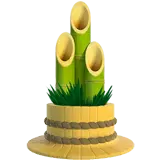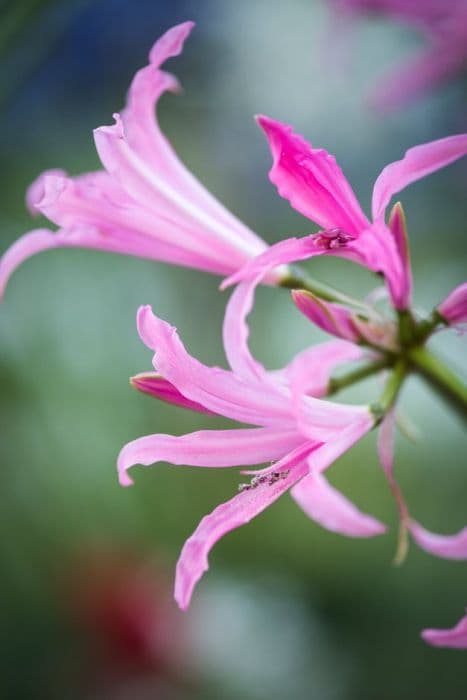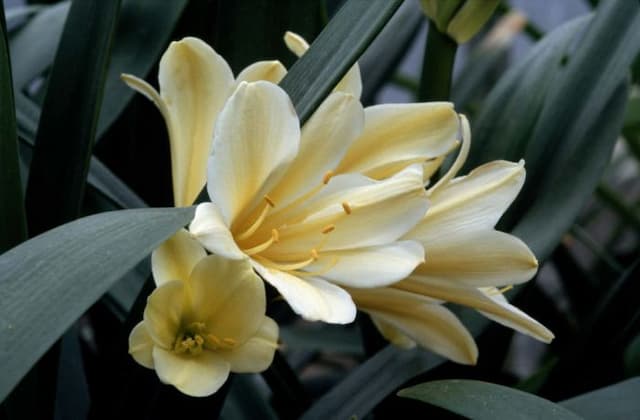Galanthus 'Sutton Courtenay'

ABOUT
The Galanthus 'Sutton Courtenay', commonly known as the snowdrop, is a charming perennial bulbous plant that is best known for its early spring blooms. It typically features a singular flower hanging from each stem, gracefully nodding as if bowing. The flowers are white and display a classic snowdrop shape, comprising three outer petal-like segments that are pure white and arch outwards, gifting the blossom with an elegant lantern-like appearance. Contrasting the outer segments are three smaller inner ones, often marked with a green or greenish-yellow pattern that can vary in design, usually at the tips. This unique marking is often what distinguishes one variety from another. The foliage of the snowdrop is also distinctive, emerging as slender, strap-shaped leaves. These leaves are a fresh, glaucous green which means they have a slight waxy or powdery look giving them a blue-green hue. The foliage remains relatively unobtrusive, allowing the delicate blooms to be the focal point of the plant through its flowering period. The snowdrop typically emerges in late winter to early spring, often poking through the last remnants of snow, hence its evocative name. The beauty of the snowdrop lies in its simplicity and the heralding of the coming spring, making it a much-beloved plant in gardens and natural woodlands where it naturalizes over time. Its overall appearance is one of purity and renewal. The plant, with its drooping white flowers set against the cool hues of the greenery, is a quintessential symbol of the poetic transition from winter's end to the awakening of the new season's life.
About this plant
 Names
NamesFamily
Amaryllidaceae
Synonyms
Snowdrop, Common Snowdrop
Common names
Galanthus 'Sutton Courtenay'.
 Toxicity
ToxicityTo humans
The common name for Galanthus 'Sutton Courtenay' is Snowdrop. Snowdrops contain alkaloids including galantamine, which can be poisonous if ingested. The symptoms of poisoning from consuming parts of the plant, such as the bulb, may include gastrointestinal upset like nausea, vomiting, and diarrhea, as well as abdominal pain. In more severe cases, ingestion can lead to dizziness, tremors, and cardiac irregularities. Prompt medical attention is suggested if ingestion occurs.
To pets
Snowdrop is the common name for Galanthus 'Sutton Courtenay'. This plant is also toxic to pets due to the presence of alkaloids such as galantamine. If pets ingest any part of the plant, particularly the bulbs, they can exhibit symptoms of poisoning. These symptoms might include vomiting, diarrhea, salivation, lethargy, and abdominal pain. In severe cases, ingestion can lead to more serious neurological signs like seizures, ataxia, or dermal irritation if they come into contact with the sap. Pet owners should consult a veterinarian immediately if their pet consumes any part of a snowdrop plant.
 Characteristics
CharacteristicsLife cycle
Perennials
Foliage type
Deciduous
Color of leaves
Green
Flower color
White
Height
4-6 inches (10-15 cm)
Spread
3-4 inches (7.5-10 cm)
Plant type
Bulb
Hardiness zones
3-8
Native area
Europe
Benefits
 General Benefits
General Benefits- Early Blooming: Galanthus 'Sutton Courtenay', commonly known as snowdrop, often blooms in late winter or early spring, providing an early burst of color when most plants are dormant.
- Attracts Pollinators: Snowdrops are known to attract bees and other pollinators, which can benefit the garden by promoting pollination of early-flowering plants.
- Low Maintenance: Snowdrops are relatively easy to care for, requiring minimal maintenance once established in an appropriate location.
- Naturalizes Well: Snowdrops can spread over time to create natural-looking drifts, adding charm to gardens and landscapes.
- Cold Tolerant: As one of the first plants to emerge in the year, snowdrops are highly tolerant of cold weather, making them suitable for colder climates.
- Drought Tolerant: Once established, snowdrops can tolerate periods of dry weather, making them relatively drought-resistant.
- Pest Resistant: Snowdrops are typically not heavily targeted by garden pests, reducing the need for chemical intervention.
- Deer and Rabbit Resistant: These plants are generally resistant to browsing by deer and rabbits, which is beneficial in gardens plagued by these animals.
- Ground Cover: Snowdrops can act as a ground cover, helping to suppress weeds and protect the soil surface from erosion.
 Medical Properties
Medical PropertiesThis plant is not used for medical purposes.
 Air-purifying Qualities
Air-purifying QualitiesThis plant is not specifically known for air purifying qualities.
 Other Uses
Other Uses- Photography subjects: Snowdrops, with their delicate white flowers, are popular among photographers and as subjects in macro photography for their aesthetic appeal and early bloom, signaling the end of winter.
- Education: Snowdrops can be used in botanical study for educational purposes to teach about plant morphology and life cycles, particularly as an example of early spring bloomers.
- Winter Gardens: They can be used to beautify winter gardens, providing contrast against the barren landscape and offering a hint of the approaching spring.
- Beekeeping: Since snowdrops are one of the first flowers to bloom, they are an important early food source for bees when not many other plants are flowering.
- Symbolism in Art: Artists may use snowdrops to symbolize purity, hope, and the rebirth of nature in their works, due to the flower's early appearance and clean appearance.
- Festivals: In some cultures, snowdrops are celebrated and festivals are dedicated to their bloom, marking the end of winter and the anticipation of spring.
- Garden Planning Tool: Gardeners sometimes plant snowdrops to serve as a biological indicator for the right timing of spring planting for other species.
- Horticultural Therapy: The presence of snowdrops in gardened spaces can be used in horticultural therapy for their uplifting effect during the tail end of winter.
- Crafting: Snowdrop flowers can be pressed and used in various crafting activities such as creating bookmarks, cards, or decorative pieces.
- Floristry: Snowdrop blooms can be used in floral arrangements, particularly winter bridal bouquets, to add a touch of natural elegance.
Interesting Facts
 Feng Shui
Feng ShuiThe Snowdrop is not used in Feng Shui practice.
 Zodiac Sign Compitability
Zodiac Sign CompitabilityThe Snowdrop is not used in astrology practice.
 Plant Symbolism
Plant Symbolism- Hope and Purity: Galanthus, commonly known as snowdrop, often symbolizes hope and purity due to its white color and its tendency to bloom in late winter, suggesting the imminent arrival of spring.
- Consolation: The snowdrop also offers consolation or comfort, especially after a trying period, akin to the respite that the first signs of spring bring after a long, harsh winter.
- Resilience: The plant's ability to thrive in cold weather and push through the snow makes it a symbol of resilience and strength against adversity.
 Water
WaterFor the Snowdrop, it’s important to keep the soil consistently moist during its growing season in the fall and early spring. Water once a week with about 1 gallon of water per square yard of soil, ensuring the moisture reaches the root zone. During dormant periods in the summer, reduce watering as the plant requires less moisture. Watering should be done in the morning to allow excess moisture to evaporate, helping to prevent the development of fungal diseases.
 Light
LightSnowdrops prefer dappled sunlight or partial shade, thriving best when shielded from the intense midday sun. An ideal spot would be under deciduous trees that allow sunlight through their branches, especially in late winter to early spring when the snowdrops are in bloom. Full sun locations can be tolerated in cooler climates, but it’s important to ensure the ground doesn't dry out completely.
 Temperature
TemperatureSnowdrops are cold-hardy plants that can endure winter temps down to about -20°F, making them suitable for many temperate regions. They flourish best when the temperature remains between 30°F and 50°F during their growth period. To ensure optimal health, avoid exposing them to prolonged temperatures over 70°F, which can cause them to enter dormancy prematurely.
 Pruning
PruningSnowdrops require minimal pruning; just remove any dead or yellowing foliage after flowering, which is typically in late spring. This tidy-up helps redirect energy to the bulbs for next season's growth. It's not necessary to prune often; once per season post-bloom is sufficient. The best time for pruning Snowdrops is when the foliage starts to naturally die back.
 Cleaning
CleaningNot needed
 Soil
SoilThe Snowdrop 'Sutton Courtenay' thrives best in a soil mix that is well-draining, enriched with organic matter like leaf mold or compost. The ideal soil pH for this plant is slightly acidic to neutral, ranging from 6.5 to 7.0.
 Repotting
RepottingSnowdrops, including 'Sutton Courtenay', are generally not repotted often; they can be left undisturbed for several years. Divide and repot every 3 to 5 years or when clumps become overcrowded.
 Humidity & Misting
Humidity & MistingSnowdrops like 'Sutton Courtenay' prefer outdoor conditions and do not generally require specific humidity levels to thrive; however, they tolerate a moderate range of humidity typical of outdoor garden environments.
 Suitable locations
Suitable locationsIndoor
Place Snowdrops in bright light, cool temps, and well-draining soil.
Outdoor
Plant Snowdrops in dappled shade with moist soil.
Hardiness zone
3-7 USDA
 Life cycle
Life cycleThe life cycle of the Galanthus 'Sutton Courtenay', commonly known as Snowdrop, begins with a bulb that contains the dormant plant. In late winter to early spring, the bulb breaks dormancy and sends up linear leaves and a single flower stalk, each bearing a nodding, white flower. After flowering, the plant undergoes pollination, which is often facilitated by early-active insects, leading to seed formation. The foliage continues to photosynthesize and store energy in the bulb until late spring when the leaves yellow and die back as the plant enters summer dormancy. During this time, the bulb is underground, enduring the dry or warm months. In the following winter, the bulb will sprout again, thus restarting the cycle.
 Propogation
PropogationPropogation time
Early Spring
Galanthus 'Sutton Courtenay', commonly known as snowdrops, is typically propagated through division, which is the most popular method among gardeners for its simplicity and effectiveness. The best time for dividing snowdrop bulbs is after the foliage has died back in late spring or early summer. To propagate by division, carefully dig up the clumps of bulbs and gently separate them by hand, ensuring that each divided bulb has a portion of the basal plate. These individual bulbs can then be immediately replanted about 3 inches deep (7.6 centimeters) and 3 inches apart (7.6 centimeters) in prepared soil that is well-drained but stays moist. It's essential to handle the bulbs carefully to avoid damaging them, as snowdrops do not respond well to drying out, and this can adversely affect their ability to establish in a new location.









